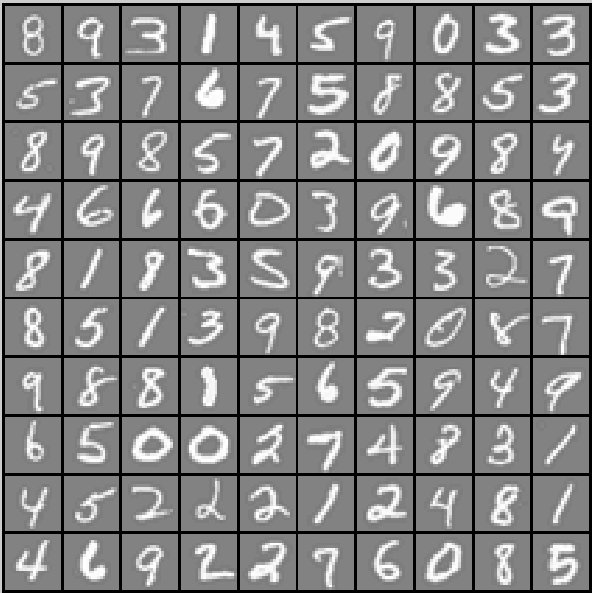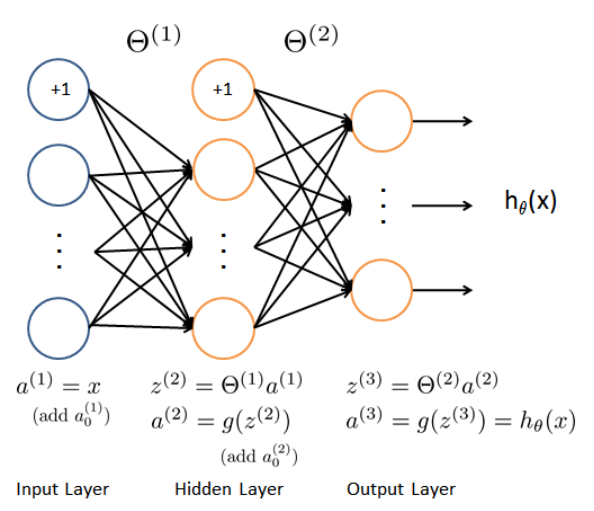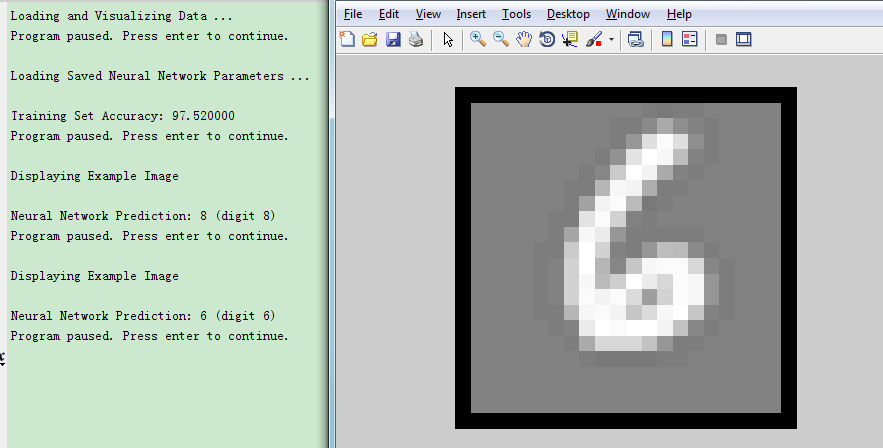用matlab實現神經網路識別數字
阿新 • • 發佈:2019-01-08
Andrew Ng機器學習第四周的程式設計練習是用matlab實現一個神經網路對一幅圖中的數字進行識別,有待識別的數字全集如下:
其中每一個數字都是一個大小為20*20畫素的影象,如果把每個畫素作為一個輸入單元,那有400個輸入。考慮到神經網路還需要增加一個額外輸入單元表示偏差,一共有401個輸入單元。題目中給的訓練資料X是一個5000*400的向量。
題目中要求包含一個25個節點的隱藏層,隱藏層也存在表示偏差的額外輸入,所以一共有26個輸入。
最終的輸出結果是一個10維的向量,分別表示該數字在0-9上面的概率值(由於沒有0這個下標位,這裡題目中把0標記為10,其餘1-9還是對應1-9),找到其中概率最大的就是要識別的結果。
神經網路的結構如下:
從上圖可以看到,神經網路中除了輸入引數外,還包含Theta1和Theta2兩個引數。
其中的Theta1就表示輸入層到隱含層中每條邊的權重,為25*401的向量。Theta2是隱含層到輸出層每條邊的權重,為10*26的向量。
為了把資料標準化減少誤差,這裡要對每一步的輸出用sigmoid函式進行處理。
構造好神經網路後,首先是用訓練資料進行訓練,得出Theta1和Theta2的權重資訊,然後就可以預測了。
主要的matlab程式碼如下:
%% Machine Learning Online Class - Exercise 3 | Part 2: Neural Networks % Instructions % ------------ % % This file contains code that helps you get started on the % linear exercise. You will need to complete the following functions % in this exericse: % % lrCostFunction.m (logistic regression cost function) % oneVsAll.m % predictOneVsAll.m % predict.m % % For this exercise, you will not need to change any code in this file, % or any other files other than those mentioned above. % %% Initialization clear ; close all; clc %% Setup the parameters you will use for this exercise input_layer_size = 400; % 20x20 Input Images of Digits hidden_layer_size = 25; % 25 hidden units num_labels = 10; % 10 labels, from 1 to 10 % (note that we have mapped "0" to label 10) %% =========== Part 1: Loading and Visualizing Data ============= % We start the exercise by first loading and visualizing the dataset. % You will be working with a dataset that contains handwritten digits. % % Load Training Data fprintf('Loading and Visualizing Data ...\n') load('ex3data1.mat'); m = size(X, 1); % Randomly select 100 data points to display sel = randperm(size(X, 1)); sel = sel(1:100); displayData(X(sel, :)); fprintf('Program paused. Press enter to continue.\n'); pause; %% ================ Part 2: Loading Pameters ================ % In this part of the exercise, we load some pre-initialized % neural network parameters. fprintf('\nLoading Saved Neural Network Parameters ...\n') % Load the weights into variables Theta1 and Theta2 load('ex3weights.mat'); %% ================= Part 3: Implement Predict ================= % After training the neural network, we would like to use it to predict % the labels. You will now implement the "predict" function to use the % neural network to predict the labels of the training set. This lets % you compute the training set accuracy. pred = predict(Theta1, Theta2, X); fprintf('\nTraining Set Accuracy: %f\n', mean(double(pred == y)) * 100); fprintf('Program paused. Press enter to continue.\n'); pause; % To give you an idea of the network's output, you can also run % through the examples one at the a time to see what it is predicting. % Randomly permute examples rp = randperm(m); for i = 1:m % Display fprintf('\nDisplaying Example Image\n'); displayData(X(rp(i), :)); pred = predict(Theta1, Theta2, X(rp(i),:)); fprintf('\nNeural Network Prediction: %d (digit %d)\n', pred, mod(pred, 10)); % Pause fprintf('Program paused. Press enter to continue.\n'); pause; end
預測函式如下:
function p = predict(Theta1, Theta2, X) %PREDICT Predict the label of an input given a trained neural network % p = PREDICT(Theta1, Theta2, X) outputs the predicted label of X given the % trained weights of a neural network (Theta1, Theta2) % Useful values m = size(X, 1); num_labels = size(Theta2, 1); % You need to return the following variables correctly p = zeros(size(X, 1), 1); % ====================== YOUR CODE HERE ====================== % Instructions: Complete the following code to make predictions using % your learned neural network. You should set p to a % vector containing labels between 1 to num_labels. % % Hint: The max function might come in useful. In particular, the max % function can also return the index of the max element, for more % information see 'help max'. If your examples are in rows, then, you % can use max(A, [], 2) to obtain the max for each row. % X = [ones(m, 1) X]; predictZ=X*Theta1'; predictZ=sigmoid(predictZ); predictZ=[ones(m,1) predictZ]; predictZZ=predictZ*Theta2'; predictY=sigmoid(predictZZ); [mp,imp]=max(predictY,[],2); p=imp; % ========================================================================= end
最終運算截圖如下:
最後與迴歸分析做個對比:
迴歸分析需要對每個數字訓練一個分類器,這裡需要訓練10個,每一個分類器迭代50次,結果為:
顯然神經網路準確率要比迴歸分析高,同時也要顯得簡潔很多,程式碼行數也明顯減少,這也正是神經網路的優勢所在。




